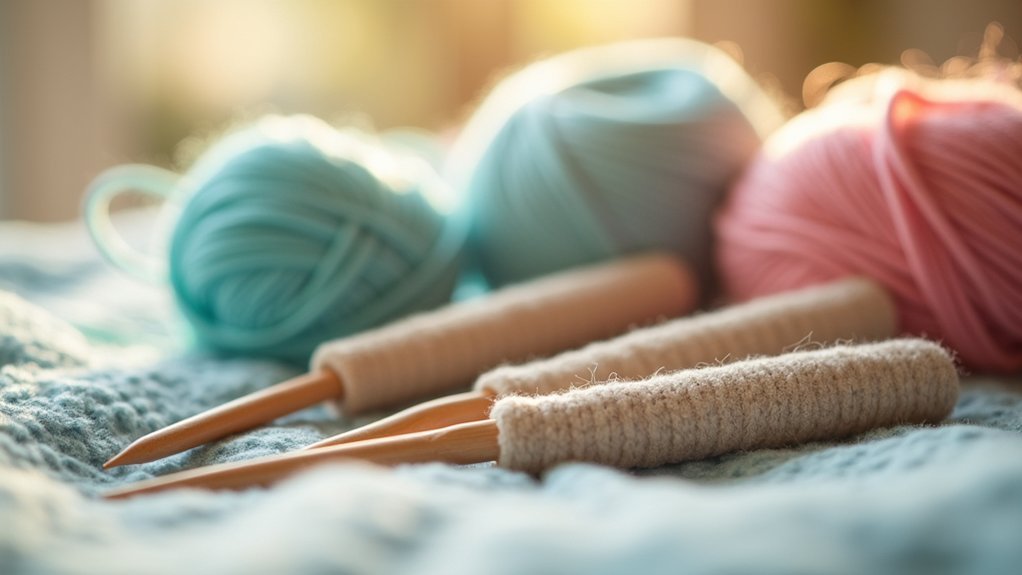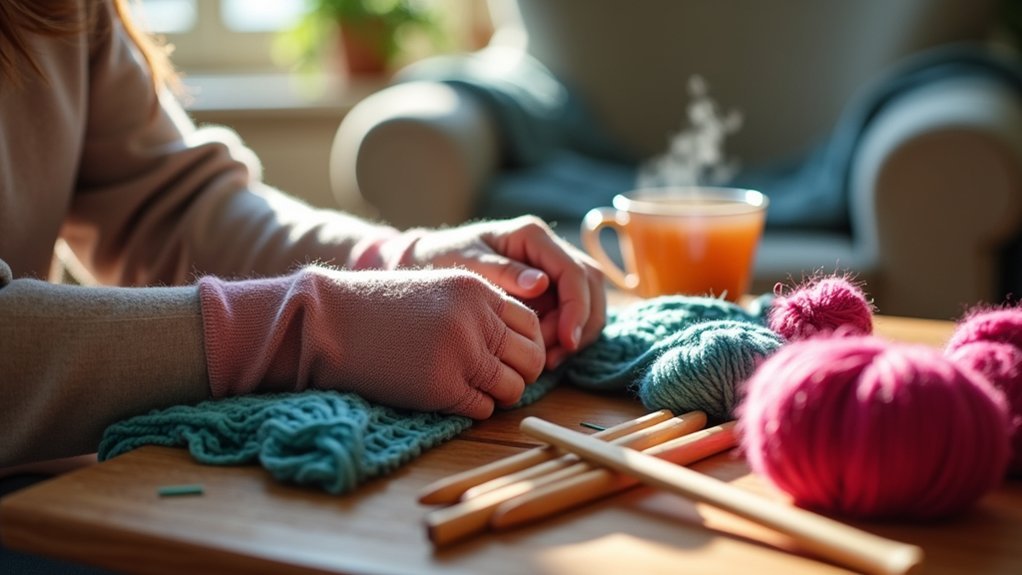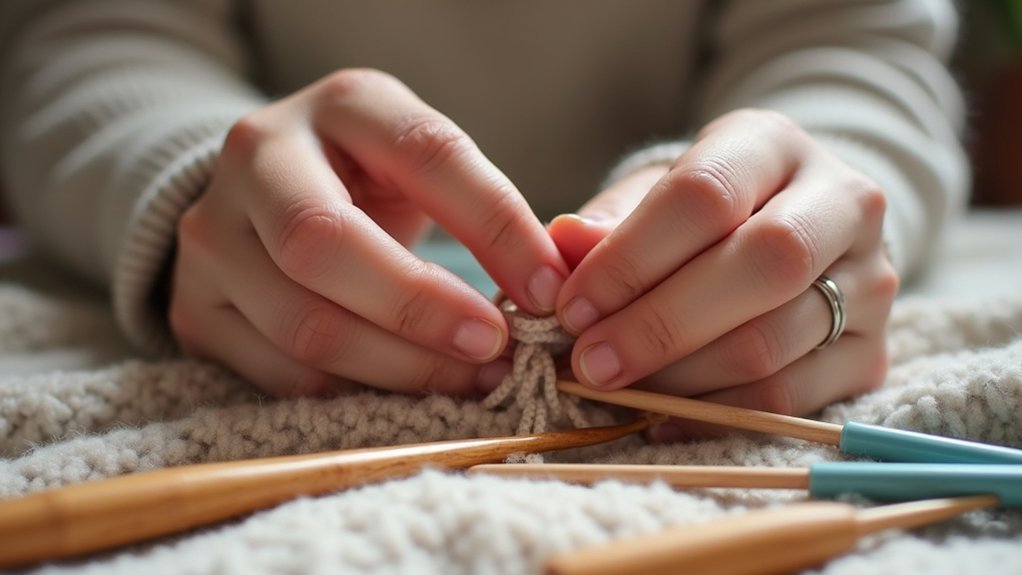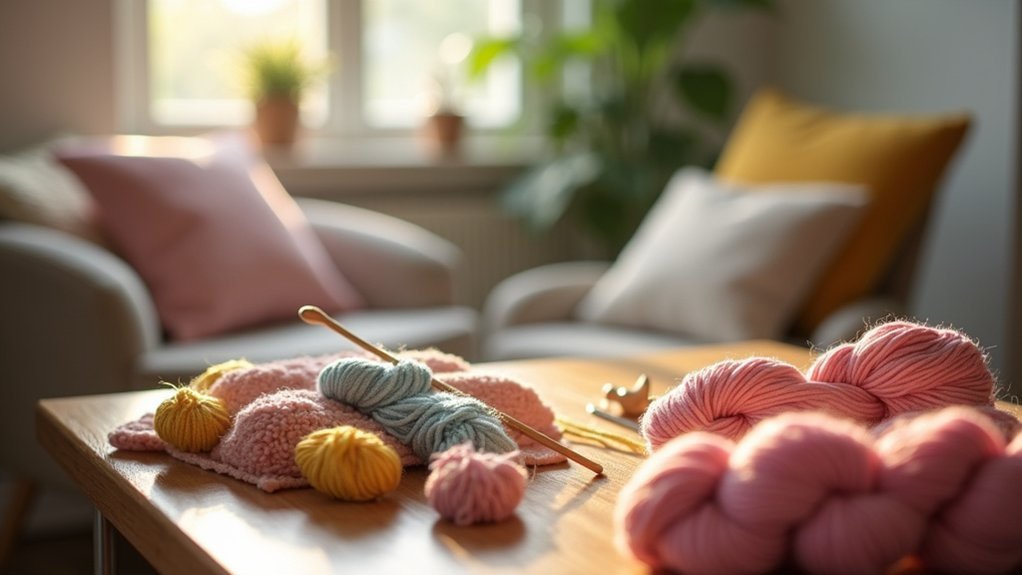For arthritic hands, ergonomic knitting tools can transform your crafting experience. Look for needles with contoured grips, lightweight materials like bamboo, and larger sizes to eliminate tight gripping. Compression gloves provide joint support while maintaining dexterity, and yarn bowls reduce wrist movement. Project holders bear the weight of larger pieces, while warming accessories like microwavable hand wraps soothe stiffness. These adaptations help you continue your creative passion without pain or limitations.
Knitting Tools That Ease Arthritis Pain

While arthritis can make your favorite crafting hobby painful, specialized knitting tools can transform the experience. The square design of ergonomic grip needles like KnitPicks Nova Cubics enhances your control while reducing finger fatigue—a game-changer if you’re dealing with joint inflammation.
Consider switching to lightweight bamboo or warm birch wood tools that won’t stress your hands during extended crafting sessions. Larger-sized needles and hooks eliminate the need for tight gripping, which often triggers pain in arthritic joints.
Don’t overlook circular knitting needles, which distribute your project’s weight more evenly across both hands, minimizing wrist strain.
For additional support, try wearing compression gloves specifically designed for crafters—they’ll stabilize inflamed joints while maintaining the dexterity you need for precise stitchwork.
Ergonomic Needle Designs That Reduce Joint Strain
Because traditional knitting needles often exacerbate arthritis pain, ergonomic alternatives have revolutionized crafting for those with joint issues.
Ergonomic needles with contoured shapes and textured grips prevent slipping and reduce hand strain during extended knitting sessions.
You’ll find many designs feature square or flat-sided profiles, like the Knitters Pride Nova Cubics, giving you better control over tension while providing a more comfortable grip.
Materials matter too—bamboo and wood needles offer soothing warmth for stiff joints.
Consider lightweight options like Prym Ergonomic Knitting Needles if you struggle with finger fatigue. Their flexible design minimizes strain, making them ideal for arthritis sufferers.
With these specialized tools, you can enjoy longer crafting periods without discomfort, ultimately improving your hand health and mobility.
Compression Gloves: Support While You Stitch

Beyond specialized needles, your hands themselves can benefit from targeted support during knitting sessions. Compression gloves offer a practical solution for crafters experiencing pain or stiffness. These gloves provide gentle pressure that improves circulation and reduces swelling while you work with yarn.
Gentle compression provides the caring support your hands need when pain threatens to interrupt your creative flow.
When selecting compression gloves for your knitting toolkit, consider these benefits:
- They deliver targeted support to sore joints while maintaining your dexterity for intricate stitches.
- The improved circulation helps reduce hand fatigue during longer crafting sessions.
- Breathable materials prevent overheating, keeping your hands comfortable.
- They encourage proper hand positioning, potentially preventing repetitive strain injuries.
Available in various sizes and compression levels, you’ll find options that fit your specific needs while providing the support your hands deserve.
Yarn Management Systems for Less Hand Movement
For knitters with arthritis, reducing unnecessary hand movements can considerably decrease pain during crafting sessions. Yarn management systems offer practical solutions that minimize strain while keeping your projects organized.
| Tool Type | Benefits | Pain Reduction |
|---|---|---|
| Yarn Bowls/Dispensers | Prevents tangles and chasing rolling balls | Minimizes wrist twisting |
| Center-Pull Winders | Creates balls that feed from inside | Reduces pulling and tugging |
| Yarn Caddies | Wheel-mounted storage for multiple yarns | Eliminates lifting heavy supplies |
Consider adding yarn guides or tension rings to maintain consistent tension without constant readjustment. For colorwork projects, bobbins can prevent tangling when working with multiple strands, allowing you to switch colors with minimal hand manipulation. These simple yarn management systems can transform your crafting experience from painful to pleasurable.
Modified Handles and Grips for Pain-Free Crafting

You’ll find immediate relief from arthritis discomfort with various grip enhancements that transform standard knitting tools into pain-free instruments.
Adaptive attachments like silicone sleeves and thumb-saving handle designs redistribute pressure across your hands, reducing strain on sensitive joints during extended crafting sessions.
Try wrapping foam or hockey tape around your favorite needles for a quick DIY solution that creates a customized grip tailored to your specific comfort needs.
DIY Grip Enhancement Techniques
Five simple modifications can transform your knitting tools into arthritis-friendly instruments.
With these DIY grip enhancement techniques, you’ll discover how to craft comfortably despite hand pain. Creating a comfortable grip doesn’t require expensive specialized tools—just common household items.
Try these approaches to customize your tools:
- Wrap hockey tape around needle handles for a cushioned, non-slip surface that reduces finger pressure.
- Slide pencil grips onto standard crochet hooks for improved comfort during extended crafting sessions.
- Cut soft foam tubing to create personalized grips that fit your unique hand shape and size.
- Apply silicone or rubber coatings to absorb shock and prevent slipping, especially helpful during long projects.
Experiment with different combinations until you find what works best for your specific needs.
Adaptive Tool Attachments
Three game-changing adaptive tool attachments can transform your knitting experience when arthritis flares up. These specialized modifications provide larger, softer surfaces that distribute pressure evenly across your hands, preventing painful pressure points.
Look for ergonomic attachments with cushioned grips or wider handles that allow for a more natural hand position. You’ll grip less tightly, reducing joint strain considerably.
Many adaptive tool attachments use flexible materials that conform to your unique hand shape, improving both comfort and control.
For an affordable solution, try simple add-ons like pencil grips or hockey tape on standard needles. Research shows these adaptive tool attachments can dramatically reduce fatigue, allowing you to craft longer without pain.
The right attachment can make all the difference between giving up your hobby and continuing to create beautiful work.
Thumb-Saving Handle Designs
Relief comes in the form of thoughtfully designed thumb-saving handles that address the specific needs of arthritic hands.
These ergonomic tools feature contoured shapes that naturally fit your palm, distributing pressure evenly to prevent joint pain during extended crafting sessions.
You’ll find thumb-saving handle designs offer significant benefits:
- Soft rubber grips provide essential cushioning, giving you a secure hold without straining your fingers.
- Larger, easy-to-grip handles accommodate various hand sizes, perfect if you have limited dexterity.
- Contoured shapes reduce thumb fatigue, allowing you to knit longer without discomfort.
- Even pressure distribution across your hand minimizes arthritis pain points.
With these modified handles, you’ll enjoy greater comfort and control, transforming painful crafting sessions into enjoyable creative time—regardless of arthritis challenges.
Adaptive Stitch Markers and Counters for Easy Tracking
You’ll find high-visibility locking markers invaluable when tracking complex patterns, as their bright colors and larger openings make them easier to place and remove with arthritic fingers.
Magnetic counter bracelets can transform your stitch-counting experience by eliminating the need to grip traditional counters, allowing you to simply tap the bracelet to advance your count.
These adaptive tools work together to reduce hand strain and frustration, letting you focus on enjoying your knitting rather than struggling with the mechanics of tracking your progress.
High-Visibility Locking Markers
While struggling to locate regular markers amid colorful yarn can be frustrating, high-visibility locking markers eliminate this common problem for knitters with arthritis.
These specialized markers securely attach to your fabric without slipping, allowing you to track your progress confidently even during long crafting sessions.
High-visibility locking markers offer several benefits for arthritic hands:
- Their bright colors and patterns make them easy to spot against any yarn color or texture
- Lightweight construction reduces hand fatigue during extended knitting sessions
- Various sizes accommodate different needle sizes and yarn thicknesses
- Ergonomic shapes with easy-grip features help those with limited dexterity
You’ll appreciate how these markers stay firmly in place until you’re ready to move them, preventing the frustration of dropped or lost stitch markers while crafting.
Magnetic Counter Bracelets
Keeping track of stitches offers yet another challenge for knitters with arthritis, which is where magnetic counter bracelets come into play. These adaptive stitch markers eliminate the need for cumbersome paper or digital counters that can be difficult to manipulate with painful joints.
You’ll appreciate how these lightweight bracelets securely hold stitch markers in place with magnets, making it effortless to monitor your progress without interrupting your flow. The ergonomic design guarantees comfort during extended knitting sessions, reducing strain on your already sensitive hands and wrists.
For those struggling with fine motor skills, magnetic counter bracelets considerably decrease the risk of losing your place in patterns.
Many designs feature colorful beads or personalized charms, adding a touch of style while maintaining their primary function as tracking tools for your knitting projects.
Lightweight Tools That Minimize Fatigue
When arthritis pain threatens to derail your knitting enjoyment, selecting the right lightweight tools becomes essential. Bamboo and warm birchwood needles reduce hand strain by weighing less than traditional metal options, allowing you to craft longer without discomfort.
Consider these lightweight knitting tools to enhance your experience:
- Square-shaped ergonomic needles that provide better grip without requiring excessive tension.
- Larger needle sizes that decrease finger strain for easier manipulation.
- Circular knitting needles that distribute weight evenly for heavier projects.
- Interchangeable crochet hooks with soft rubber handles for comfortable gripping.
Pair these tools with smooth yarns like merino or bamboo for the ultimate arthritis-friendly crafting setup.
You’ll notice immediate relief as you’re able to enjoy your favorite hobby with considerably less pain.
Project Holders and Stands to Support Your Work
The right tools go beyond just the needles in your hands. Project holders and stands serve as essential allies in your battle against arthritis pain, supporting your work while you focus on creating.
These ingenious devices hold your knitting at adjustable heights and angles, eliminating the need to hunch over or maintain uncomfortable positions. You’ll find your wrists and hands experience less strain as the stand bears the weight of larger projects, distributing pressure away from sensitive joints.
Many stands feature thoughtful yarn management compartments that keep your skeins organized and tangle-free, ensuring smooth progress on your project.
For crafters who enjoy knitting in various locations, portable project holders let you maintain proper ergonomics wherever you go, making it possible to continue your beloved hobby without aggravating arthritis symptoms.
Warming Tools and Accessories for Joint Comfort
Warm tools can transform your knitting experience by reducing joint stiffness and arthritis pain before you even pick up your needles.
You’ll find relief with microwavable hand wraps that conform to your joints, heated needle storage cases that keep your tools comfortably warm, and simple warm water soaks that increase flexibility in just minutes.
These warming accessories work alongside your ergonomic tools to create a complete comfort system for your hands during extended crafting sessions.
Microwavable Hand Wraps
Soothing your aching joints before or after a knitting session can dramatically improve your crafting experience.
Microwavable hand wraps offer targeted relief for stiff, painful hands while you enjoy your fiber arts passion. These therapeutic accessories contain natural materials like rice or flaxseed that retain heat effectively, providing warmth exactly where you need it.
For maximum benefit from your hand wraps:
- Heat for the recommended time (usually 1-2 minutes)
- Shape the wrap around your hands and wrists for contoured comfort
- Leave in place for about 20 minutes to improve circulation
- Use before knitting to increase flexibility or after to reduce inflammation
Some wraps even include aromatherapy scents, adding a calming element to your pain relief routine while you prepare for your next knitting project.
Heated Needle Storage
Heating isn’t just for your hands—your knitting tools can benefit from warmth too. Heated needle storage options can remarkably reduce joint discomfort by softening cold metal or hard plastic needles before you begin your project. These warming accessories help alleviate stiffness and make your tools more comfortable to handle.
| Storage Type | Benefits |
|---|---|
| Warming Cases | Maintains consistent temperature for extended periods |
| Heated Bags | Portable option for on-the-go knitters |
| Microwavable Pouches | Quick activation, no electricity needed |
| Thermal Wraps | Dual-purpose: can warm hands and needles |
| Heat-Retention Sleeves | Keeps needles warm throughout your project |
Incorporating heated needle storage into your routine not only eases arthritis symptoms but also promotes muscle relaxation while you work. Simply warm your tools before starting, and you’ll likely notice improved comfort and enhanced enjoyment of your craft.
Warm Water Soaks
Preparing your hands before each knitting session can make a tremendous difference in your comfort level.
Warm water soaks are a simple yet effective method to reduce stiffness and improve joint mobility before picking up your needles.
Here’s how to maximize the benefits of warm water therapy:
- Soak your hands in comfortably warm water for 5-10 minutes before knitting to increase blood circulation.
- Combine soaking with gentle finger and wrist stretches to enhance flexibility.
- Try microwavable warm packs for targeted heat therapy when a full soak isn’t convenient.
- Make warm water soaks a regular part of your routine for long-term improvements in hand dexterity.
These warming techniques can greatly improve your grip on tools and yarn, allowing you to enjoy your craft with less pain and greater comfort.
Tech-Assisted Knitting Aids for Reduced Hand Strain
While traditional knitting can exacerbate arthritis symptoms, modern technology now offers innovative solutions that can transform the crafting experience.
Tech-assisted knitting aids, particularly electronic knitting machines, automate repetitive motions that typically cause joint pain, allowing you to continue creating beautiful pieces without the strain.
Smart tools equipped with tension sensors eliminate the need for manual adjustments that can trigger discomfort. You’ll find Bluetooth-enabled needles especially helpful as they track your progress and remind you when it’s time for a break, preventing overuse injuries.
For more precise work, consider adaptive crochet hooks with rotating handles and built-in grips that improve maneuverability even with limited hand strength.
These ergonomic options with adjustable needle grips distribute pressure more evenly across your fingers and joints.
Frequently Asked Questions
Which Knitting Needles Are Best for Arthritis?
You’ll find ergonomic options like Knitters Pride Nova Cubics with square shapes ideal for arthritis. Choose lightweight bamboo or chunky needles, or try Prym’s three-sided design for better grip and reduced strain.
Can Knitting Help With Arthritis?
Yes, knitting can help with your arthritis. It provides gentle hand exercise, improves mobility, increases blood circulation, and offers pain distraction. You’ll maintain dexterity while enjoying a creative outlet that soothes both mind and hands.
What Helps Excruciating Arthritis Pain?
For excruciating arthritis pain, you’ll find relief with compression gloves, warmth therapy, and regular breaks with stretching. Don’t forget to try anti-inflammatory medications, physical therapy, and maintaining proper joint alignment throughout the day.
What Are the Assistive Devices for Arthritis Pain?
You can use ergonomic braces, compression gloves, heated mitts, splints, walking aids, grab bars, jar openers, button hooks, electric can openers, and modified utensils to manage your arthritis pain throughout daily activities.
In Summary
Don’t let arthritis steal your knitting joy. You’ve got options that’ll transform your crafting experience—from ergonomic needles to compression gloves and project stands. These specialized tools work together to reduce strain, minimize pain, and keep your hands comfortable. By investing in the right equipment, you’ll extend your knitting sessions and protect your joints while continuing to create beautiful handmade treasures.





Leave a Reply